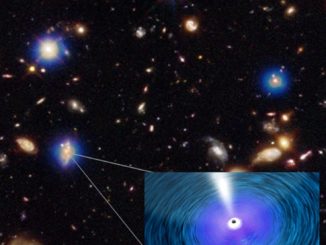Stellar-mass black holes are impressive enough, but the supermassive black holes at the cores of most, if not all, well-formed galaxies are truly mind boggling. But for sheer head-scratching amazement, consider a black hole tipping the scales at some 30 billion solar masses.
That’s what a Durham University-led team found using a technique known as gravitational lensing. Using a supercomputer to analyse the light from a background galaxy, they determined the best explanation was the gravity of an ultramassive black hole at the heart of a foreground galaxy that warped the light on its way to the Hubble Space Telescope.

To make their computer models match the Hubble data, a black hole with the mass of 30 billion Suns was required. It is the first example of a black hole found by matching up computer modelling and observational data.
“This particular black hole, which is roughly 30 billion times the mass of our Sun, is one of the biggest ever detected and on the upper limit of how large we believe black holes can theoretically become, so it is an extremely exciting discovery,” said Durham University’s James Nightingale, lead author of a paper in Monthly Notices of the Royal Astronomical Society.
“Most of the biggest black holes that we know about are in an active state, where matter pulled in close to the black hole heats up and releases energy in the form of light, X-rays, and other radiation.
“However, gravitational lensing makes it possible to study inactive black holes, something not currently possible in distant galaxies,” he said. “This approach could let us detect many more black holes beyond our local universe and reveal how these exotic objects evolved further back in cosmic time.”
The research was supported by the the United Kingdom Space Agency, the Royal Society, the Science and Technology Facilities Council and the European Research Council.



